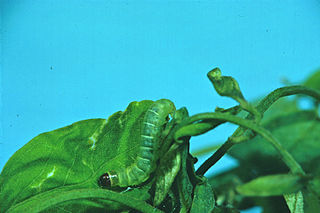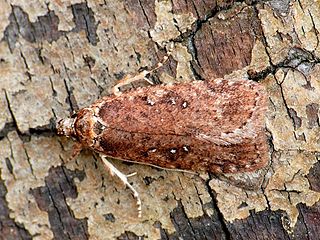
Agonopterix arenella is a species of moth of the family Depressariidae. It is found in all of Europe, except the Iberian Peninsula.

Agonopterix ocellana is a species of moth of the family Depressariidae. It is found in Europe and was first described by Johan Christian Fabricius in 1775

Agonopterix robiniella, the four-dotted agonopterix moth or locust leaf roller, is a moth of the family Depressariidae. It is found in North America, where it has been recorded to appear in places from Nova Scotia to Georgia, west to Oklahoma, north to Illinois, Michigan and southern Ontario.

Mesapamea secalis, the common rustic, is a moth of the family Noctuidae. The species was first described by Carl Linnaeus in his 1758 10th edition of Systema Naturae. It is found in Europe, north-west Africa, Turkey and northern Iran.

Xylena vetusta, the red sword-grass, is a moth of the family Noctuidae. The species was first described by Jacob Hübner in 1813. It is found in the Palearctic realm from northwestern Africa through Europe and Asia up to central Siberia. In the north it is found up to the Arctic Circle and Iceland.

Archanara dissoluta, the brown-veined wainscot, is a moth of the family Noctuidae. The species was first described by Georg Friedrich Treitschke in 1825. It is found in most of Europe, east into Russia and Siberia.

Agonopterix heracliana is a moth of the family Depressariidae. It is found in most of Europe, North Africa, the Near East, and the eastern part of the Palearctic realm. It was first described in 1758 by Carl Linnaeus in the 10th edition of Systema Naturae.

Agonopterix conterminella is a moth of the family Depressariidae which is found in Asia, Europe and North America. It was described by Philipp Christoph Zeller in 1839 from a specimen found in Augsburg, Germany. The larvae feed on the terminal shoots of willows.

Agonopterix yeatiana is a moth of the family Depressariidae. It is found in most of Europe.
Agonopterix arnicella is a moth in the family Depressariidae. It was described by Walsingham in 1881. It is found in North America, where it has been recorded from Alberta, Ontario, Washington, Oregon and California.
Agonopterix nubiferella is a moth in the family Depressariidae. It was described by Walsingham in 1881. It is found in North America, where it has been recorded from northern California to British Columbia.
Agonopterix posticella is a moth in the family Depressariidae. It was described by Walsingham in 1881. It is found in North America, where it has been recorded from Washington to California and in Wyoming and Colorado.
Agonopterix psoraliella is a moth in the family Depressariidae. It was described by Walsingham in 1881. It is found in North America, where it has been recorded from California to Washington, Utah, South Dakota and Arizona.
Agonopterix sabulella is a moth in the family Depressariidae. It was described by Walsingham in 1881. It is found in North America, where it has been recorded from Idaho, Alberta and British Columbia and from Washington to Arizona and California.
Agonopterix pavida is a moth in the family Depressariidae. It was described by Edward Meyrick in 1913. It is found in Asia Minor.
Agonopterix remota is a moth in the family Depressariidae. It was described by Edward Meyrick in 1921. It is found in Palestine.
Exaeretia hildaella is a moth in the family Depressariidae. It was described by John Frederick Gates Clarke in 1941. It is found in North America, where it has been recorded from Alberta and the Northwest Territories.
Exaeretia umbraticostella is a moth in the family Depressariidae. It is found in North America, where it has been recorded from South Dakota and British Columbia to Texas and California.
Agonopterix rubristricta is a moth in the family Depressariidae. It was described by Walsingham in 1912. It is found in Guatemala.
Antaeotricha trichonota is a species of moth of the family Depressariidae. It is found in Brazil and Paraguay.









